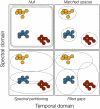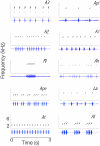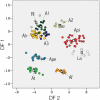Acoustic interference and recognition space within a complex assemblage of dendrobatid frogs
- PMID: 21969562
- PMCID: PMC3193210
- DOI: 10.1073/pnas.1104773108
Acoustic interference and recognition space within a complex assemblage of dendrobatid frogs
Abstract
In species-rich assemblages of acoustically communicating animals, heterospecific sounds may constrain not only the evolution of signal traits but also the much less-studied signal-processing mechanisms that define the recognition space of a signal. To test the hypothesis that the recognition space is optimally designed, i.e., that it is narrower toward the species that represent the higher potential for acoustic interference, we studied an acoustic assemblage of 10 diurnally active frog species. We characterized their calls, estimated pairwise correlations in calling activity, and, to model the recognition spaces of five species, conducted playback experiments with 577 synthetic signals on 531 males. Acoustic co-occurrence was not related to multivariate distance in call parameters, suggesting a minor role for spectral or temporal segregation among species uttering similar calls. In most cases, the recognition space overlapped but was greater than the signal space, indicating that signal-processing traits do not act as strictly matched filters against sounds other than homospecific calls. Indeed, the range of the recognition space was strongly predicted by the acoustic distance to neighboring species in the signal space. Thus, our data provide compelling evidence of a role of heterospecific calls in evolutionarily shaping the frogs' recognition space within a complex acoustic assemblage without obvious concomitant effects on the signal.
Conflict of interest statement
The authors declare no conflict of interest.
Figures






References
-
- Jones G. Acoustic signals and speciation: The roles of natural and sexual selection in the evolution of cryptic species. Adv Stud Behav. 1997;26:317–354.
-
- Ryan MJ, Rand AS. Sexual selection and signal evolution: The ghost of biases past. Philos Trans R Soc Lond B Biol Sci. 1993;340:187–195.
-
- Hunter ML, Krebs JR. Geographical variation in the song of the great tit (Parus major) in relation to ecological factors. J Anim Ecol. 1979;48:759–785.
-
- Irwin DE. Song variation in an avian ring species. Evolution. 2000;54:998–1010. - PubMed
-
- Welch AM, Semlitsch RD, Gerhardt HC. Call duration as an indicator of genetic quality in male gray tree frogs. Science. 1998;280:1928–1930. - PubMed
Publication types
MeSH terms
LinkOut - more resources
Full Text Sources
Miscellaneous

